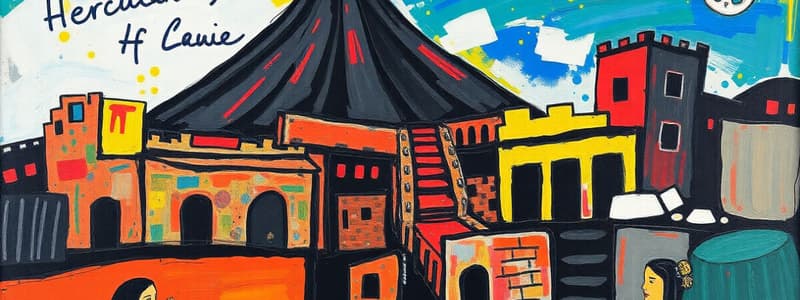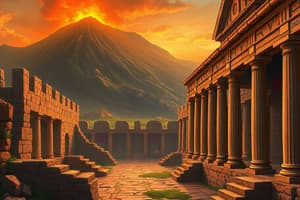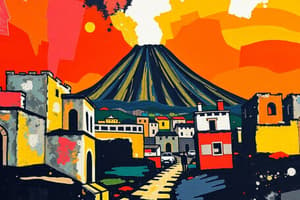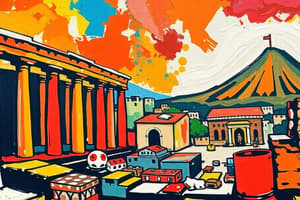Podcast
Questions and Answers
What significant event occurred in AD 79 that impacted Herculaneum?
What significant event occurred in AD 79 that impacted Herculaneum?
- Herculaneum was attacked by a rival city.
- Mount Vesuvius erupted, burying the city in volcanic ash. (correct)
- An earthquake struck the city causing destruction.
- A tsunami flooded the coastal area.
What material was used to replace the original black sand at the restored beach in Herculaneum?
What material was used to replace the original black sand at the restored beach in Herculaneum?
- A dark-colored material resembling the original sand. (correct)
- White coral sand for aesthetic purposes.
- Light-colored synthetic sand for comfort.
- Natural pebbles to create a beach-like atmosphere.
What can visitors do at the restored beach of Herculaneum?
What can visitors do at the restored beach of Herculaneum?
- Participate in archaeological excavations.
- Swim in the sea as the Romans did.
- Attend reenactments of ancient Roman festivals.
- See the site from the same position as ancient Roman people. (correct)
Why was Herculaneum a popular destination for upper-class families in ancient Rome?
Why was Herculaneum a popular destination for upper-class families in ancient Rome?
What was the belief about the local residents of Herculaneum following the initial excavations?
What was the belief about the local residents of Herculaneum following the initial excavations?
What discovery in subsequent excavations challenged the early beliefs about the fate of Herculaneum's inhabitants?
What discovery in subsequent excavations challenged the early beliefs about the fate of Herculaneum's inhabitants?
What does the skeleton known as the 'Ring Lady' signify about the inhabitants of Herculaneum?
What does the skeleton known as the 'Ring Lady' signify about the inhabitants of Herculaneum?
What does evidence suggest about the skeleton of the Roman soldier found near the remains of a boat?
What does evidence suggest about the skeleton of the Roman soldier found near the remains of a boat?
Flashcards
Herculaneum
Herculaneum
An ancient Roman city located on the west coast of central Italy that was buried by volcanic ash in AD 79.
Vesuvius Eruption
Vesuvius Eruption
The eruption of Mount Vesuvius that occurred in AD 79, burying Herculaneum and Pompeii in volcanic ash.
Roman Soldier Skeleton
Roman Soldier Skeleton
The remains of a Roman soldier discovered in Herculaneum, suggesting he was on a rescue mission when he perished.
Ring Lady
Ring Lady
Signup and view all the flashcards
Volcanic Ash Burial
Volcanic Ash Burial
Signup and view all the flashcards
Herculaneum Skeletons
Herculaneum Skeletons
Signup and view all the flashcards
Herculaneum Beach
Herculaneum Beach
Signup and view all the flashcards
Excavation
Excavation
Signup and view all the flashcards
Study Notes
Mount Vesuvius Eruption and Herculaneum
- Mount Vesuvius erupted in AD 79, burying Herculaneum, a seaside resort near Pompeii.
- The Herculaneum beach, buried for almost 2,000 years, was recently excavated and opened to the public in 2024.
- The restored beach is now accessible to visitors and exhibits the black sand original to the site, and was reconstructed to accommodate wheelchairs.
- The ancient beach allows visitors to experience a remarkably preserved Roman beach.
Herculaneum's Discovery and Restoration
- Herculaneum was a popular Roman resort town with mild weather.
- It lay hidden under 150+ feet of volcanic ash until accidentally discovered in 1709.
- 18th and 19th-century excavations uncovered structures, artifacts, scrolls.
- Initial excavations found few human remains, suggesting possible escape before the eruption
- Subsequent excavations (1980s-2000s) unearthed over 300 skeletons, suggesting residents fled to the beach, seeking rescue.
- Remains of children, women, and babies were found within boat houses.
- Skeletons of men were found on the beach, possibly on rescue missions
- Archaeological findings provide insights into Roman daily life
- Remarkable finds include the Ring Lady (with jewels) and a Roman soldier's skeleton (with weaponry).
Ongoing Excavations
- Excavations at Herculaneum, Pompeii, and surrounding areas are still ongoing, yielding new discovery
- Recent finds include a shrine with blue walls and a banquet room with ancient war paintings.
Studying That Suits You
Use AI to generate personalized quizzes and flashcards to suit your learning preferences.





